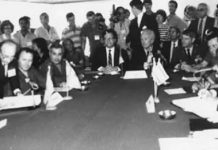Stone Age for Stone Age
Nadim Koteich/Asharq Al Awsat/22 August 2023
العصر الحجري مقابل العصر الحجري
نديم قطيش/الشرق الأوسط/22 آب/2023
معادلة التوازن الجديدة بين ميليشيا «حزب الله» وإسرائيل التي بشرنا بها حسن نصر الله، ومفادها «العصر الحجري مقابل العصر الحجري»، ليست سوى دليل إضافي على حجم الانفصال عن الواقع الذي يعاني منه الرجل، وفقر معارفه بالتاريخ وديناميات القوة.
يعيدنا نصر الله، عبر معادلته، إلى لغة الحرب الباردة، ونظرية توازن الرعب من الدمار النووي الشامل المؤكد والمتبادل، بين الولايات المتحدة والاتحاد السوفياتي. إغراء التشبيه مغرٍ بلا شك، لكنه أبعد ما يكون عن الواقع.
تعاني هذه المعادلة من الخلل الداخلي ذاته الذي عانته معادلة توازن الرعب إبان الحرب الباردة. تغاضى المنظرون حينها واليوم عن الفوارق الشاسعة بين عناصر القوة غير المسلحة على طرفي النزاع. لم ينهر الاتحاد السوفياتي في نهاية المطاف بسبب نقص في جاهزيته النووية، بل بسبب التصدع المجتمعي والقيمي الداخلي ورداءة النظام الاقتصادي وفشله.
على هذا النحو، تبدو معادلة نصر الله غافلة عن اختلال ميزان القوة غير المسلحة لصالح إسرائيل. فالناتج المحلي الإسرائيلي هو 522 مليار دولار، في حين أن الناتج المحلي اللبناني بالكاد يتجاوز 21 ملياراً مقروناً بمعدلات تضخم فلكية تتجاوز 185 في المائة، بالإضافة إلى انهيار العملة والتصدع القطاعي الشامل، الذي جعل البنك الدولي يصف ما يعانيه لبنان بأسوأ أزمة اقتصادية يعرفها البلد منذ 150 سنة! وفيما تحتل إسرائيل المرتبة 16 في العالم على مؤشر الابتكار العالمي بين 132 دولة، والأولى في شمال أفريقيا وغرب آسيا، يبدو لبنان عاجزاً عن تأمين الكهرباء لمطاره الدولي!
ولعل الفارق الأغرب هو الفارق السياسي وفارق العلاقات الدولية بين البلدين، بحيث إن لبنان تراجع إلى ما يشبه العزلة، بعد عقود من التألق في المنتديات الإقليمية والدولية، في حين أن علاقات إسرائيل تبدو أوثق من علاقات لبنان نفسه. أما الفارق الثقافي، وهو ما كان على الدوام من ملامح الشخصية اللبنانية المميزة، فبات خارج أي سياق منطقي للمقارنة مع التفوق الحاسم للإنتاجات الإسرائيلية مثلاً عبر منصات «نتفيلكس» و «آبل» كمسلسلي «فوضى» و«طهران»، على سبيل المثال لا الحصر.
يقدم هذا الموجز صورة عن الخلل المتعدد الأوجه بين دولتين تلعبان على أرضين مختلفتين تماماً، ما يؤكد الطبيعة الوهمية للتوازن والتماثل في علاقاتهما ومصادر قوتهما.
وحتى لو اكتفينا بالأبعاد العسكرية لمعادلة التوازن، سنجد أن تقديم الطرفين كمصارعين متساويين، ليس سوى نظرة تبسيطية تتجاهل بشكل خطير واقع التفوق الإسرائيلي في مجال التكنولوجيا العسكرية. قبل أيام فقط أعلنت إسرائيل أنّ الولايات المتّحدة أجازت لها إبرام صفقة عسكرية «تاريخية» بقيمة 3.5 مليار دولار تبيع بموجبها إسرائيل لألمانيا منظومات دفاع جوي فرط صوتية من نوع «آرو-3»، في أضخم صفقة عسكرية تبرمها إسرائيل في تاريخها.
التاريخ حافل بأمثلة عن لاعبين صغار انتصروا على خصوم يفقونهم قوة وشراسة، لكن سياق هذه الانتصارات غالباً ما انطوى على حروب تحرير أو مقاومة ضد الاحتلال، وهو سياق مختلف جذرياً عن الديناميكيات الحالية بين لبنان وإسرائيل. إن هزيمة الاتحاد السوفياتي في أفغانستان في الثمانينات، على يد مقاومة محلية شرسة، والتحديات الهائلة التي واجهها الجيش الإسرائيلي في لبنان، أو يواجهها في فلسطين، أمثلة واضحة تؤكد قدرة المقاومات على تحقيق نتائج ضد قوة محتلة بصرف النظر عن الفارق النوعي بين الاثنين. بيد أن الوضع بين لبنان وإسرائيل اليوم مختلف بشكل ملحوظ، حيث نجد أنفسنا إزاء شيء أقرب إلى لعبة توازن عسكري تقليدي بين دولتين، لا لعبة تحرير واحتلال، في ضوء أن لا احتلال إسرائيلي فعلي للبنان، بل جيوب حدودية قليلة متنازع عليها. وفي مثل هذا السياق المحدد لمواجهة شبه تقليدية بين لبنان وإسرائيل، فإن الأمثلة نادرة جداً على حالات تمكن فيها اللاعب الأصغر من هزيمة الخصم الأكبر والأكثر تطوراً.
ثم إن معادلة نصر الله تنطوي على عيوب عميقة. إن استسهال إعادة مجتمعات بأكملها إلى العصر الحجري فكرة منزوعة العصب الأخلاقي، جرى امتحان شبيهاتها في كل اليوتوبيات القاتمة التي أعلت مقام الآيديولوجيا على الإنسان. إنها استراتيجية لا تقبل فقط احتمال الدمار واسع النطاق بل تتبناه كشكل شرعي من أشكال الردع، من دون أي توقف عند التبعات المجتمعية الكارثية والخسارة المحتملة في الأرواح.
المريع أكثر أن معادلة نصر الله تتجاهل ما يمكن للدبلوماسية أن تحققه. يقدم حل النزاع البحري بين إسرائيل ولبنان، الذي أدى إلى بدء جهود استكشاف الغاز في المياه اللبنانية الجنوبية، درساً في قدرة الدبلوماسية على إنتاج فوائد متبادلة بين لبنان وإسرائيل قابلة للتوسع والاستدامة. سيقال طبعاً إنه ما تحقق ذلك إلا بسبب وجود السلاح. حسناً! لنضع للسلاح هذه الوظيفة إذن، وليُستثمر السلاح في خلق فرص تفاوضية لاستعادة مزارع شبعا، إن ثبتت لبنانيتها، ولإنهاء ترسيم الحدود وربما لإحياء اتفاق الهدنة، أو ربما للدخول في مسار السلام الشامل الناشط اليوم. وليكن السلاح أداة في تعزيز موقع لبنان ضمن منظومة المصلحة العربية المشتركة. في عالم السياسة الواقعية، يمكن لترسانة ميليشيا «حزب الله» أن تعزز الموقف التفاوضي للبنان، وأن تخدم مصالح اللبنانيين. لكن هذه الفكرة سرعان ما تنهار عندما نتذكر الآيديولوجية الأساسية التي تحرك «حزب الله»، ككيان يغذيه شغف عقائدي بتدمير إسرائيل، وشغف مذهبي ثأري ضد المحيط العربي، حتى لو كان الثمن تدمير لبنان برمته. إن معادلة نصر الله «العصر الحجري مقابل العصر الحجري» ليست خاطئة ومعيبة وحسب، بل هي تأكيد على أن فكرة تحويل قدرات ميليشيا «حزب الله» العسكرية إلى رصيد دبلوماسي ليست سوى خيال سياسي، يخدم تأبيد هيمنة السلاح على حياة اللبنانيين.
Stone Age for Stone Age
Nadim Koteich/Asharq Al Awsat/22 August 2023
Hassan Nasrallah heralded a new modus vivendi between Hezbollah and Israel: “Stone Age for Stone Age.” This is nothing but another testament to how far detached from reality this man is, and how weak his senses of history and power dynamics are.
With his formula, Nasrallah takes us back to the rhetoric of the Cold War, and the theory of a balance of terror created by the mutually assured nuclear destruction that would ensue in the event of a nuclear conflict between the United States and Soviet Union. The analogy is certainly tempting, but it’s not accurate.
However, this formula shares the flaw of the Cold War’s balance of terror formula. Both then and today, those behind the theory have overlooked the vast gap between the rivals’ nonmilitary power. The Soviet Union did not collapse due to an issue with its nuclear readiness towards the end, but because of domestic social and moral cracks, as well as the failures of its economic system. Along these lines, Nasrallah’s formula seemingly overlooks the fact that the balance of nonmilitary power tilts in Israel’s favor. Israel has a GDP of $522 billion, while Lebanon’s GDP hardly exceeds $21 billion, and it is coupled with astronomical inflation rates (above 185 percent), the collapse of its currency, and the disruption of entire sectors. Indeed, the World Bank has called Lebanon’s current crisis the worst that the country has seen in 150 years! And while Israel ranks 16th among the 132 countries included on the Global Innovation Index, and first among the countries of North Africa and West Asia, Lebanon seems unable to secure electricity to its international airport! The strangest difference might be the gap in the countries’ political fortunes. Lebanon has regressed into a kind of international isolation after decades of performing brilliantly in regional and international forums; meanwhile Israel seems to have built more robust global ties than Lebanon itself. As for the cultural gap – and culture has always been a hallmark distinguishing Lebanon – it has made any comparison of them as competitors untenable. The unequivocal superiority of Israeli productions, for example, is evident from the performance of Israeli shows like “Fauda” and “Tehran”, to name a few, on streaming services like Netflix and Apple.
This sums up the multifaceted imbalances of power between the two countries. They are playing on separate fields, affirming the derangement of seeing their relationship as balanced and their sources of strength as symmetric.
Even if we were to focus exclusively on the military balance, we would find that presenting the two sides as equal belligerents would be simplistic. Indeed, to do so is to ignore the reality of Israel’s superiority in the field of military technology. Just a few days ago, Israel announced that the United States had authorized a “historic” $3.5 billion arms deal that will see Israel sell Germany “Arrow-3” hypersonic air defense systems, in what is the largest military deal that Israel has concluded in its history.
History is laden with examples of small players defeating stronger and fiercer opponents. However, these victories are often attained in wars of liberation or resistance against occupation, a radically different context to that of the current dynamics between Lebanon and Israel. The defeat of the Soviet Union in Afghanistan at the hands of fierce local resistance in the 1980s, and the monumental challenges that the Israeli army previously faced in Lebanon and is currently facing in Palestine, clearly demonstrate that resisting occupation, regardless of the gulf between the two sides, can yield results.
However, Lebanon and Israel have a markedly different relationship today. We find ourselves faced with something more like a game of traditional military confrontation between two states rather than a game of liberation and occupation. Indeed, Israel is not currently occupying Lebanon; there is only a dispute over a few border enclaves. In this particular context, one of a semi-traditional confrontation, examples of a smaller player defeating a larger and more developed opponent are few and far between.
Nasrallah’s formula is also deeply shameful. Minimizing the gravity of taking entire societies back to the Stone Age reflects a lack of any moral fiber. It mirrors the ideas tested by the dark utopias that raised ideology above humanity. This strategy not only tolerates the prospect of mass destruction, but embraces it as a legitimate form of deterrence without flinching at the catastrophic societal consequences or the lives that would be lost.
Worse still, Nasrallah’s formula ignores what diplomacy can achieve. The deal to settle the maritime border dispute between Israel and Lebanon, which allowed for gas exploration to begin in waters of South Lebanon, is a testament to diplomacy’s capacity for ensuring the interests of both Lebanon and Israel.
This is a sustainable approach that can be broadened. The predictable response is that this was only achieved because of Hezbollah’s arms. Great then! This ought to become the function of this arsenal, it ought to be invested in enhancing Lebanon’s negotiating position and to restore Lebanese sovereignty over the Shebaa Farms, if they are shown to be Lebanese, and to resolve other border disputes. It could perhaps be used to revive the armistice agreement as well, or perhaps to become part of the ongoing comprehensive peace process. The arsenal ought to be a tool that strengthens Lebanon’s position among its Arab partners. Seeing things from a realpolitik lens, Hezbollah’s arsenal can improve Lebanon’s negotiating position and serve the interests of the Lebanese. However, it immediately becomes apparent this is impossible once we recall what kind of ideology that drives Hezbollah, as an entity driven by its ideological fervor that leaves it determined to destroy Israel and avenge its grudge against its Arab neighbors, even if the price is the destruction of the entire country. Nasrallah’s formula “Stone Age for Stone Age” is not only wrong and flawed, but it affirms that the idea of channeling the capabilities of Hezbollah into diplomatic efforts is nothing but a political fantasy that serves to perpetuate its hegemony over the Lebanese by force of arms.























